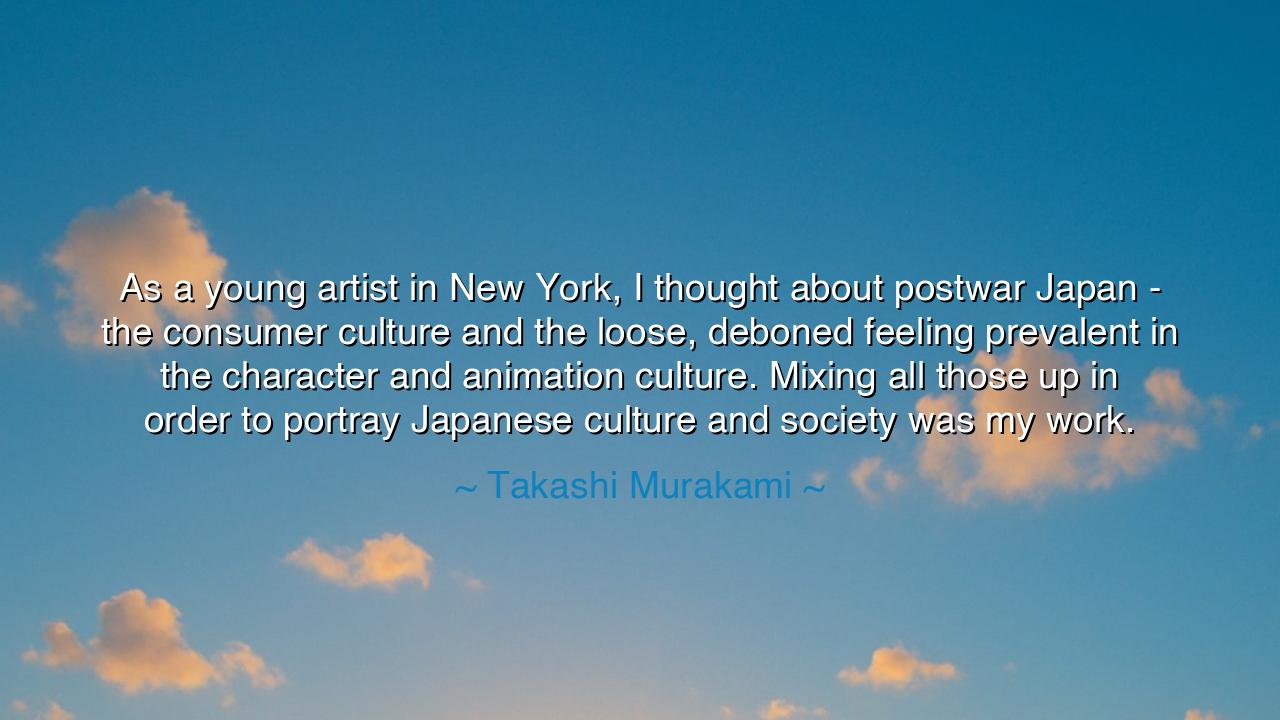
As a young artist in New York, I thought about postwar Japan -
As a young artist in New York, I thought about postwar Japan - the consumer culture and the loose, deboned feeling prevalent in the character and animation culture. Mixing all those up in order to portray Japanese culture and society was my work.






Hear the voice of Takashi Murakami, the artist who wove the pop and the profound into a single tapestry, who declared: “As a young artist in New York, I thought about postwar Japan—the consumer culture and the loose, deboned feeling prevalent in the character and animation culture. Mixing all those up in order to portray Japanese culture and society was my work.” These words carry within them the weight of history, the scars of war, and the strange beauty that rises when a people remakes itself from ruins.
The meaning is layered, like the colors in Murakami’s canvases. He speaks of postwar Japan, a nation scarred by defeat and nuclear devastation, yet reborn in a frenzy of industrial growth and consumer culture. Out of loss and survival grew a society that sought solace in goods, in images, in the playful but sometimes hollow world of animation. Murakami felt this atmosphere as “loose, deboned”—a body stripped of its old marrow, moving but unanchored, vibrant yet fragile. To capture this contradiction—both joy and emptiness—became the essence of his work.
This insight is not his alone. History testifies that the art of any age mirrors its deepest wounds and desires. After the horrors of the Black Death, Renaissance Europe turned to luminous paintings, radiant Madonnas, and visions of order, as though beauty could heal trauma. After the Great War, artists of the Dada movement embraced absurdity, mocking meaning itself, because meaning had been shattered in the trenches. So too, in Japan after World War II, manga, anime, and pop art flourished—not merely as entertainment, but as cultural therapy, a means to both remember and forget.
Murakami’s genius was to recognize this, and to mix it boldly with global influences. In New York, the city of modern art, he encountered Andy Warhol’s consumer icons, the rawness of street culture, the towering language of Western galleries. He did not reject these; he absorbed them, weaving them with the colors of Japanese animation and the fragile spirit of a nation remade. His art became what he called Superflat—a world without depth, radiant and empty, playful and unsettling, a mirror of society that had lost its bones yet danced on the surface.
The lesson here is profound: art is not only beauty but also testimony. Murakami shows us that to portray a society, one must confront both its triumphs and its fractures. To ignore its wounds is to paint lies; to confront them honestly is to create a mirror that awakens. The “deboned” feeling he described is not weakness—it is truth. And truth, even when fragile, carries power. For when a people sees itself in art, it may begin to understand, and when it understands, it may begin to heal.
We must learn from this: in our own lives, when we see the cracks of society, we should not hide them beneath false brightness. Rather, we must name them, portray them, mix them into the work of our hands. Whether through art, speech, or daily labor, we are all interpreters of our time. To create honestly is to give future generations a faithful witness of what it meant to live in this age.
Therefore, take practical action: support artists who dare to tell the truth of their culture, seek art not only that pleases but that unsettles, and when you create, let your work embrace the contradictions of the world around you. Do not fear complexity, for it is in the mixture of joy and sorrow, fullness and emptiness, that the truest image of humanity is found.
So remember Murakami’s words: “Mixing all those up in order to portray Japanese culture and society was my work.” His art is a testimony that out of ruin can come renewal, out of emptiness can come expression, and out of a fractured past can come a vision that speaks across nations. Let us too take up the task of mixing, shaping, and portraying our age, that those who come after may see not illusions, but truth made visible.






AAdministratorAdministrator
Welcome, honored guests. Please leave a comment, we will respond soon